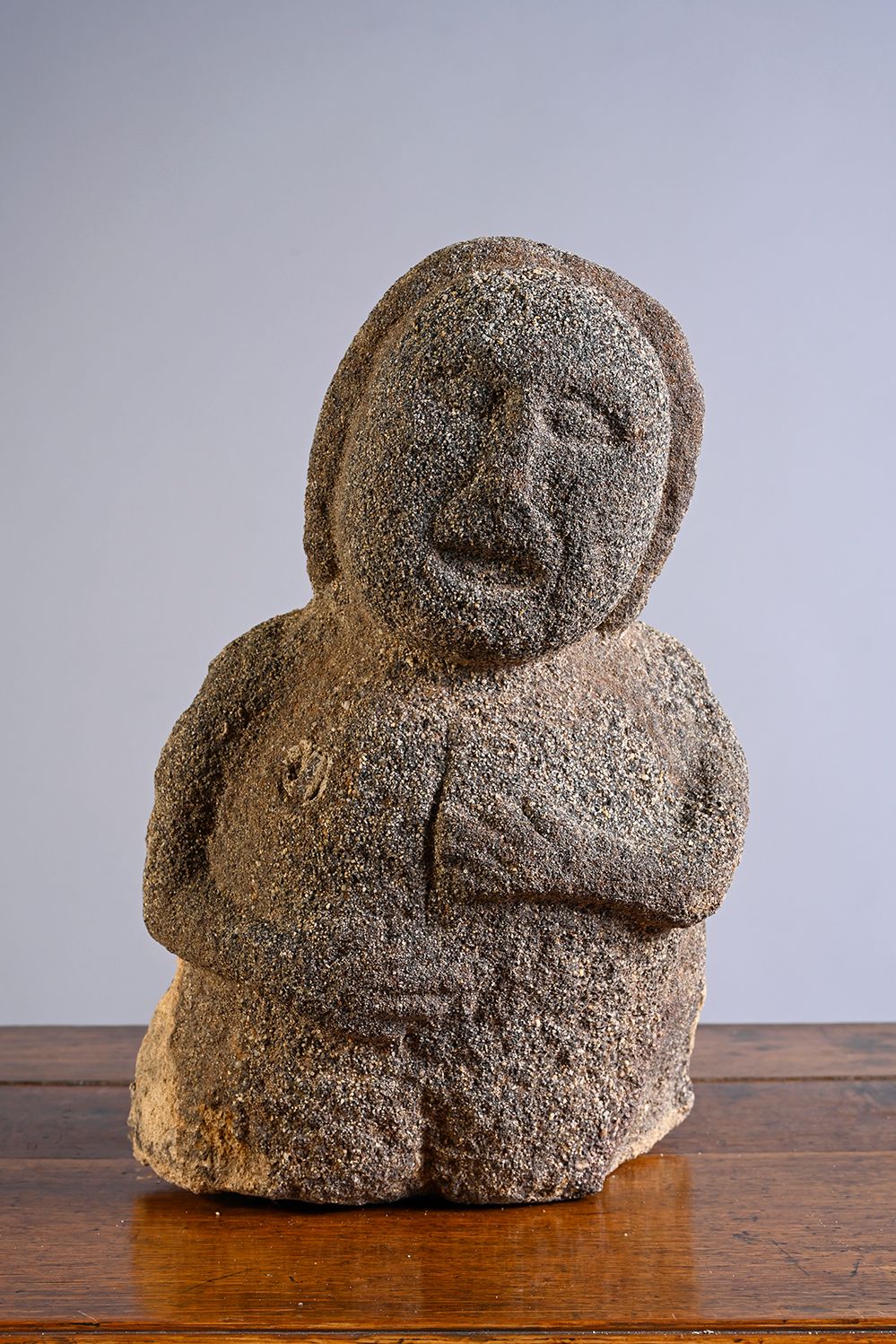Description
Bust of a character in granite or arkose sculpted in the round. Round head, with blunt nose, almond-shaped eyes, slightly stretched mouth, the two arms come back to the front, the hands placed on the torso, one higher than the other. Celtic art, Brittany, 6th / 3rd century B.C. H. : 45 cm (erosion) Provenance : Former collection of Louis-Pierre Bresset, Château de la Rochelambert, Haute-Loire. This bust of a deity must be compared to those that are nowadays kept in museum collections. The closest work is undoubtedly the bust of the bard with the lyre, found in the fortress of Paule, in the Côtes-d'Armor in 1988 and preserved in Rennes at the DRAC of Brittany (fig a). The eyes, the mouth, the nose, the rounded shape of the face refer us to our bust. Concerning the position of the hands, we find the same disposition in the figure of the warrior of Hirschlanden, (fig b), found in the tumulus of Hirschlanden, region of Ludwisburg, Baden-Wurtembers and preserved in Stuttgart at the Wurttembergisches Landesmuseum. The interest here in this simple-looking sculpture is to find a work before Romanization and the introduction of the canons of the empire, which gives it a rare kind of purity. Book consulted: Christiane Eluère, L'art de Celtes, Paris, 2004 Collection Louis-Pierre Bresset (Marseille 1902 - Paris 1988) Louis-Pierre Bresset was born in Marseille in 1902, from a family of industrialists, he became passionate about the fine arts at a very early age, assiduously attending the gallery of one of his maternal uncles, Jules Olive, a painter and art dealer on Boulevard Longchamp. After studying engineering, he left the family foundry and decided to devote himself to the world of art by opening his first gallery on rue Paradis in 1924. He quickly became fascinated with the Middle Ages and started a personal collection while directing his business towards the High Period, a specialty that was developing at the time, associated with Primitive Arts. After his marriage and the birth of his sons Edouard and Gabriel, he acquired shortly before the war the castle of La Rochelambert in the Haute-Loire, an empty shell that he gradually refurbished and transformed into a museum open to the public to present his collection of sculptures, objets d'art, tapestries and furniture from the Middle Ages and the Renaissance, including French as well as Italian, German, Flemish and Spanish works. In 1954 he moved to Paris where he opened the Quai Voltaire gallery, taking over the premises of the machand Arthur Sambon, already specialized before the war in Haute Epoque. The gallery was soon taken over by his son Edouard, while Gabriel opened the gallery on Boulevard Saint Germain in 1968. In addition to the Château de la Rochelambert, Louis-Pierre Bresset installed part of his collection in his apartment on the rue du Bac, innovating with a bold decoration in saturated colors and an original confrontation between Haute Epoque and contemporary works and furniture.
33
Bust of a character in granite or arkose sculpted in the round. Round head, with blunt nose, almond-shaped eyes, slightly stretched mouth, the two arms come back to the front, the hands placed on the torso, one higher than the other. Celtic art, Brittany, 6th / 3rd century B.C. H. : 45 cm (erosion) Provenance : Former collection of Louis-Pierre Bresset, Château de la Rochelambert, Haute-Loire. This bust of a deity must be compared to those that are nowadays kept in museum collections. The closest work is undoubtedly the bust of the bard with the lyre, found in the fortress of Paule, in the Côtes-d'Armor in 1988 and preserved in Rennes at the DRAC of Brittany (fig a). The eyes, the mouth, the nose, the rounded shape of the face refer us to our bust. Concerning the position of the hands, we find the same disposition in the figure of the warrior of Hirschlanden, (fig b), found in the tumulus of Hirschlanden, region of Ludwisburg, Baden-Wurtembers and preserved in Stuttgart at the Wurttembergisches Landesmuseum. The interest here in this simple-looking sculpture is to find a work before Romanization and the introduction of the canons of the empire, which gives it a rare kind of purity. Book consulted: Christiane Eluère, L'art de Celtes, Paris, 2004 Collection Louis-Pierre Bresset (Marseille 1902 - Paris 1988) Louis-Pierre Bresset was born in Marseille in 1902, from a family of industrialists, he became passionate about the fine arts at a very early age, assiduously attending the gallery of one of his maternal uncles, Jules Olive, a painter and art dealer on Boulevard Longchamp. After studying engineering, he left the family foundry and decided to devote himself to the world of art by opening his first gallery on rue Paradis in 1924. He quickly became fascinated with the Middle Ages and started a personal collection while directing his business towards the High Period, a specialty that was developing at the time, associated with Primitive Arts. After his marriage and the birth of his sons Edouard and Gabriel, he acquired shortly before the war the castle of La Rochelambert in the Haute-Loire, an empty shell that he gradually refurbished and transformed into a museum open to the public to present his collection of sculptures, objets d'art, tapestries and furniture from the Middle Ages and the Renaissance, including French as well as Italian, German, Flemish and Spanish works. In 1954 he moved to Paris where he opened the Quai Voltaire gallery, taking over the premises of the machand Arthur Sambon, already specialized before the war in Haute Epoque. The gallery was soon taken over by his son Edouard, while Gabriel opened the gallery on Boulevard Saint Germain in 1968. In addition to the Château de la Rochelambert, Louis-Pierre Bresset installed part of his collection in his apartment on the rue du Bac, innovating with a bold decoration in saturated colors and an original confrontation between Haute Epoque and contemporary works and furniture.
